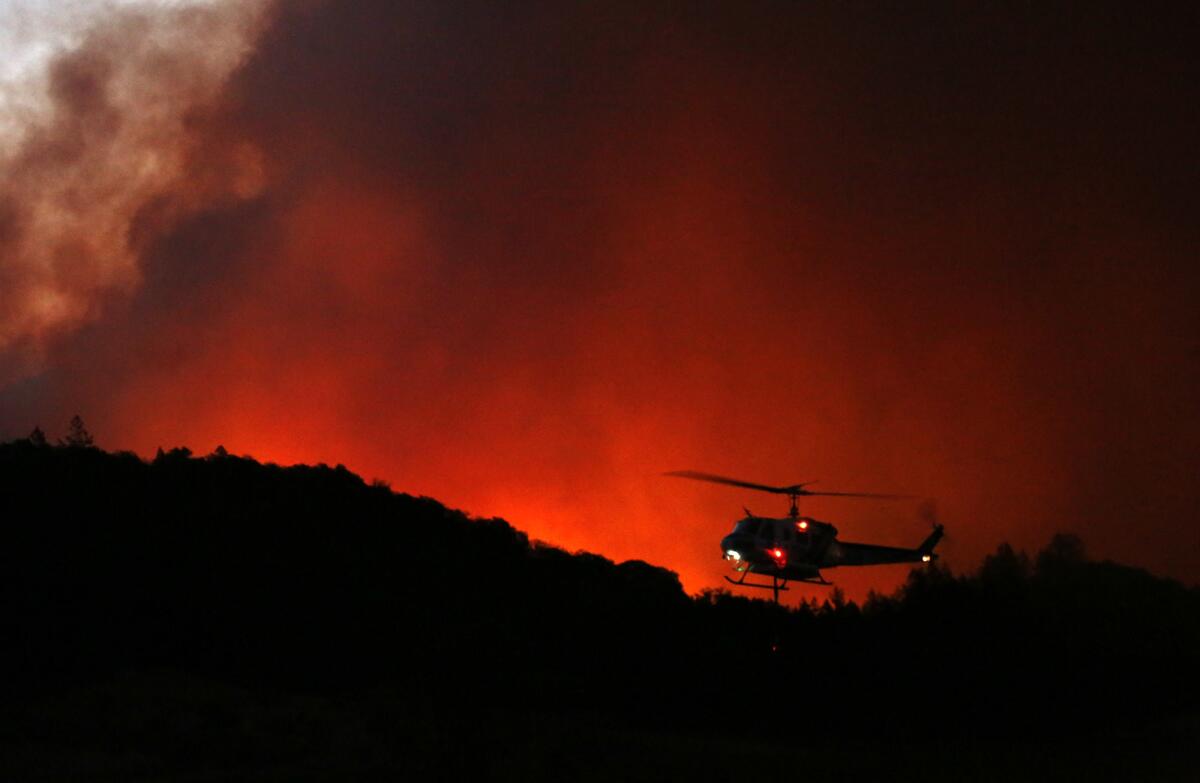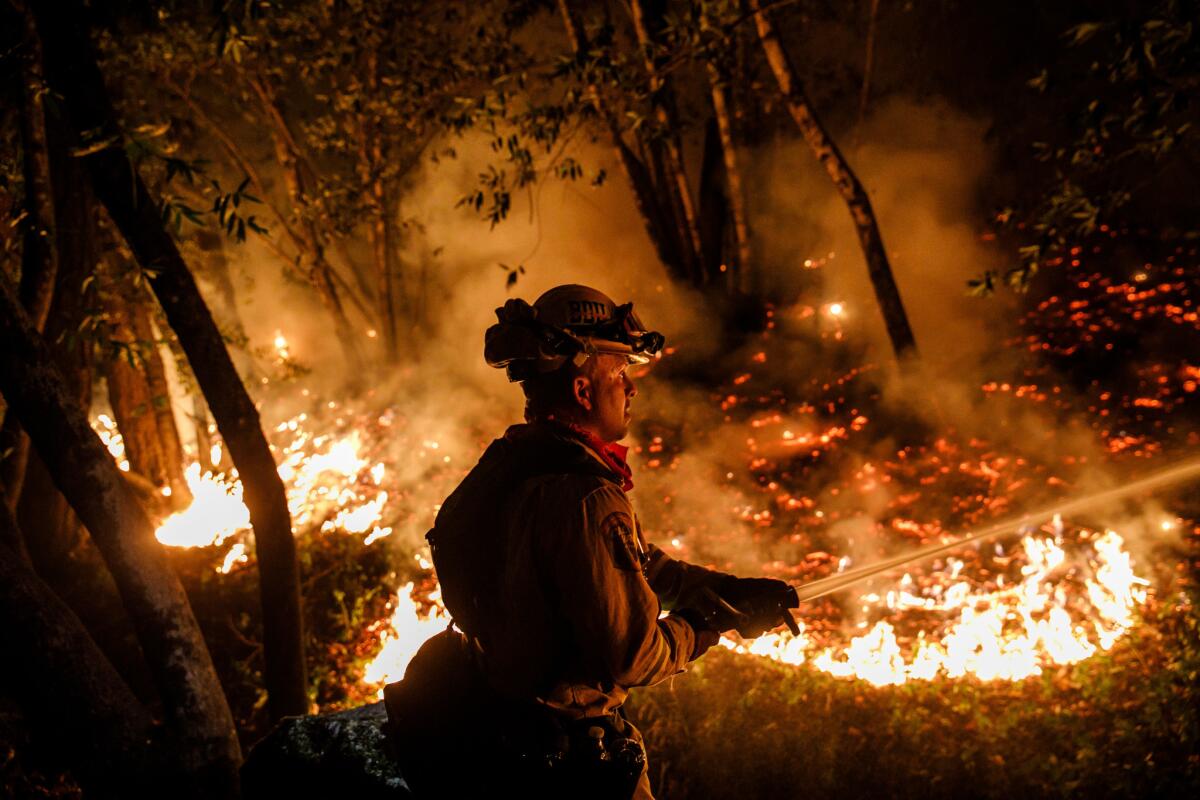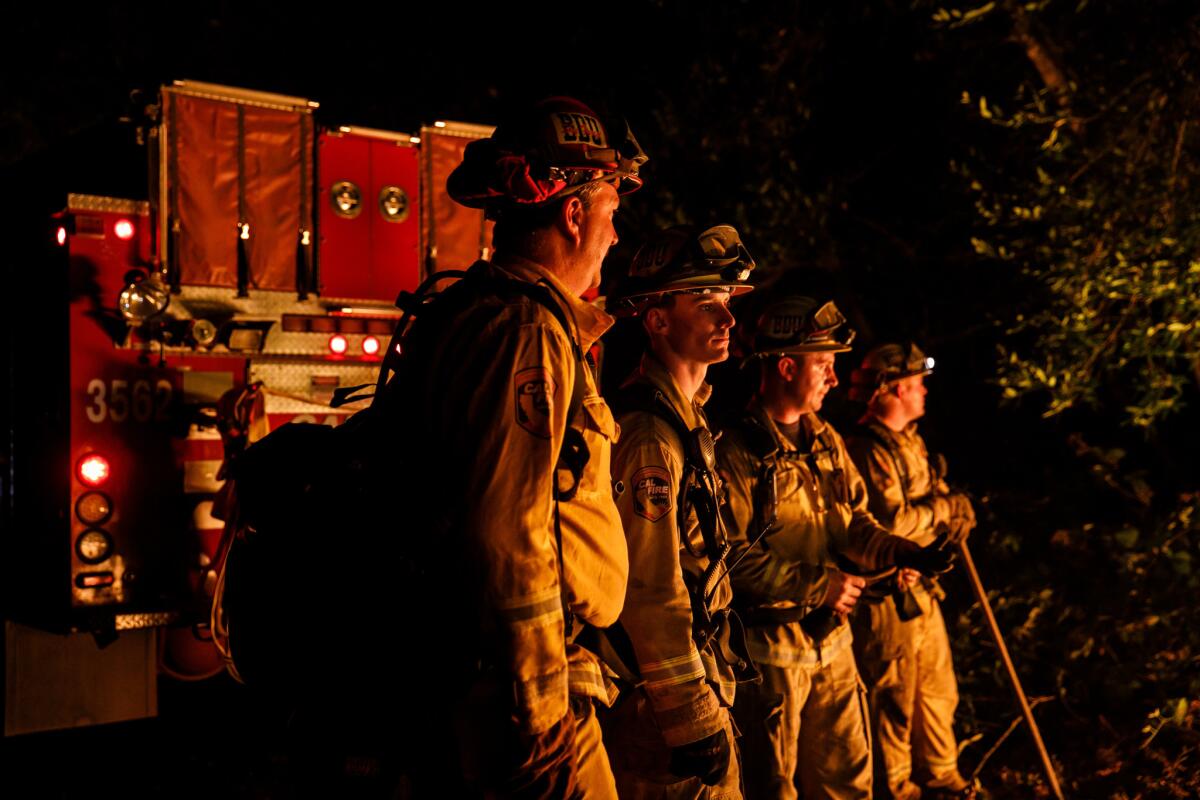Wine country lacked water-dropping aircraft in first hours of wildfires
- Share via
In the first critical hours of
It was not until the next morning, Oct. 9, that they were able to move in by air to fight the fires that eventually destroyed more than 5,000 structures and killed more than 40 people in neighborhoods in Sonoma and Napa counties.
The problem is that there were no firefighting helicopters or planes in the region capable of flying at night.
In the case of the wind-whipped wine country fires, officials say, it’s doubtful more air support that night would have made a major difference, but it’s a resource gap they plan to fill.

WOULD NIGHT DROPS HAVE HELPED?
‘Like trying to stop a tornado’
“The idea that a helicopter or night-flying air attack would stop a fire in the middle of night really is a misconception,” said Daniel Berlant, assistant director of planning for the California Department of Forestry and Fire Protection. “Aircraft have slowed down fires when conditions are right, but ground crews are the critical force.”
Other fire experts agreed, saying the force of the winds and flames were so intense that water drops probably would have done little to halt the flames during those first critical hours.
“Stopping a wildfire of this ferocity and intensity is like trying to stop a tornado,” said Robert Baird, director of fire and aviation management for the U.S. Forest Service in California. Night flights can be “hugely beneficial,” he said, but “there is a huge limitation when the wind is blowing.”
Still, with Northern California experiencing a string of deadly wildfires in recent years, experts said it would make sense for the region to have more night-dropping choppers on hand.

L.A. NIGHT DROPS HAVE SAVED THE DAY
‘It really depends on the fire’
Night flights have made a big difference in other cases, and some departments have increased those capabilities.
The
In 2008, the department got attention for a daring night flight during a fire that threatened upscale homes as well as the Getty Museum in Brentwood.
Just this week, a brush fire in Griffith Park barely had time to get bigger than an acre before helicopters drenched it with precision water drops and ground crews snuffed what was left.
LAFD spokesman Brian Humphrey said a night attack can make a big difference, but there are significant limitations during a huge wind-whipped blaze.
“The issue of air attack: This is the sad thing, it’s not succinct,” Humphrey said. “It really depends on the fire.”
The issue of air attack: This is the sad thing, it’s not succinct. It really depends on the fire.
— LAFD spokesman Brian Humphrey
The Atlas fire in Napa County was spotted by chance by a passing
The Tubbs fire in Sonoma County began about the same time. But it moved more slowly, taking an hour before mushrooming and making its run toward Santa Rosa, destroying whole neighborhoods.
There are only two helicopters in the region capable of night flight, both operated by the California Highway Patrol. Essentially flying ambulances, neither is equipped to drop water or fire retardant, and the craft spent the first night of the Atlas fire airlifting trapped residents out of harm’s way.
Cal Fire, the state’s primary firefighting agency, has no aircraft capable of night flight. The U.S. Forest Service has one, based at the Angeles National Forest. The rest are largely operated by county and city fire departments all in the south, including Santa Barbara, Ventura, Kern and Los Angeles counties and the city of L.A.
None of Cal Fire’s helicopters can fly at night because they have single engines, increasing the risk of danger if that engine should fail, Berlant said.
Cal Fire planes and helicopter pilots were told before dawn that Monday to be prepared to head to Napa and Sonoma counties to help battle the fires, Berlant said.
Incident commanders on the Atlas and Tubbs fires requested night-flying helicopters, and one was sent north from the Kern County Fire Department. But it did not get there until the second night of the fires, Berlant said.

NEW RESOURCES FOR CAL FIRE
More aircraft that can be used at night on the way
Cal Fire intends to require night-flying capabilities on a fleet of new helicopters that will eventually replace 12 Vietnam War-era military choppers. It received authorization last year to spend $12 million for the first replacement but has not yet bought that aircraft.
Wildland firefighting expert Bill Gabbert, who retired after 33 years with the National Park and U.S Forest services to run an online news outlet, Fire Aviation, said agencies lose some of the most critical hours by not staffing night and pre-dawn flights.
In some cases, dropping water on fires at night can be effective because temperatures are cooler and winds are calmer than during the day. But Gabbert said these drops are less effective during nights of heavy winds.
From an ecosystem view, the wine country fires were not new nor different.
Fire history maps show most of what burned in the Atlas fire was consumed by another fire 30 years ago. The total loss back then was 65 homes.
The order to evacuate homes in Santa Rosa when the Tubbs Fire was breaking away from Calistoga was based on fire history. Similar winds kicked off another wildland fire siege two years ago: the Valley Fire that swept into and through the community of Middletown. State maps overlaid with all fires since 1970 make the region look like a crazy quilt.
Urban development changes the equation, elevating the risk of loss by putting people and expensive homes in the way and increasing the public demand to do more, even if it might not always help.
Firefighters who would have focused on stopping the advance of a wildland fire now find themselves assigned to defend and protect structures, Gabbert said.
“Air attack is extremely popular. There’s pressure on incident management to use them,” said Gabbert.
Night flights have been an issue of debate in recent years. After the deadly Station fire hit L.A. County in 2009, a Times investigation found that the U.S. Forest Service misjudged the threat posed by the blaze and did not allow water drops the first night. A federal audit in 2011 called on the Forest Service to develop a strategy for when planes and helicopters should be flown at night. The agency now has a night-flying chopper in the region.
A lack of water-dropping helicopters also became an issue in San Diego after the massive 2003 Cedar fire burned thousands of homes. Since then, the region has increased its firefighting aircraft arsenal.
Times Staff Writer Adam Elmahrek contributed to this report.
ALSO
Thousands displaced by Northern California's wildfires now face the region's housing shortage
For families of dozens missing in California wildfires, 'it’s emotional limbo'
UPDATES:
3 p.m.: Updated with additional details on fire history in the region.
Published at 9:10 a.m.
Sign up for Essential California
The most important California stories and recommendations in your inbox every morning.
You may occasionally receive promotional content from the Los Angeles Times.








